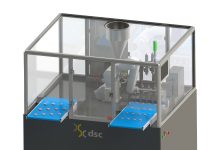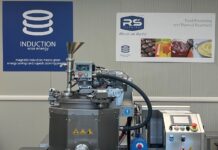Reversing the effects, the process remains valid in the case of very sliding products, for which a decrease of the cylinders’ temperature causes an increase of the product’s adhesion on the same cylinders. Today there are refining machines with work tables that can be 1 to 2.5 m long, for whose operating we need different power requirements. We should also consider that even the steel cylinder has its elasticity and when it is put under stress the cylinder itself will tend to flex at its center, with the evident disadvantage of causing a large discrepancy (in terms of microns) in the refining result. This inevitable deformation can and should be corrected by the application of a cylinder pre-deformation, which will vary its profile (camber). Often an incorrect camber is at the basis of the disadvantages found in the course of chocolate grinding. The productivity of cylinder refining or pre-refining machines depends on the fineness required on the finished product, so, in general, finest products mean more reduced grinding openings and therefore lower productivity. The dual-stage grinding process, offers more advantages than the single-stage process. Besides obtaining an optimal grain size product entering the refining machine, it offers the possibility to achieve a product with more homogeneous characteristics, for example a product that has less particle dispersion than the one made by dry grinding of sugar. We must also say that pre-refining allows having at our disposal a fat rate that normally we don’t have with pre-ground sugar. Refining must be kept under control by measures of fineness, which are generally made by micrometers, so as to ensure the continuity of production constancy. In particular, it is advisable to control the incoming and outgoing fineness at each new mixing. For a more detailed comparison between the two different technologies, we can summarize the salient points which may explain better why pre-refining is preferable. Working with powdered sugar, we will obtain:
1. little homogeneous grain size;
2. extraneous tastes (off-flavor), the typical “metallic” flavor, resulting from sugar grinding;
3. risks of explosions of the mixtures of powdered sugar and air;
4. environmental pollution, both of acoustic type, and for the formation of powdered sugar;
5. energy costs for mixing of relevant entities.
Adopting the technique of pre-refining (besides eliminating all problems that arise from the use of sugar milling), we obtain instead the following advantages:
1. superior characteristics of grain size homogeneity of the mass feeding the final refining machine;
2. possibility of standardizing the rheological properties of the dough to be refined;
3. improvement of the aromatic characteristics of the product;
4. possibility of reducing energy costs and mixing times;
5. possibility of reducing the fat content of the refining mixtures;
6. 10-20% productivity increase of the refining lines due to better conditions of grain size uniformity and rheological conditions.




